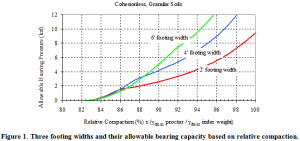Aaron B. Smith and Dr. Travis Gerber, Civil and Environmental Engineering
Introduction
When soils are compacted, they become stronger and experience less settlement. Because of these improved characteristics, soils are usually compacted to some specified level before a foundation is built on top of them. The difficulty encountered is how to determine what the specified level of compaction should be. Currently, the standard in industry has been to compact almost all foundation soils to a minimum of 95% of the maximum laboratory density. Why do engineers almost without exception choose 95%? As stated by Monahan, (1994) industry appears to be fixated with 95%. Should there be a guideline for selecting what this number should be? Surely 95% can’t be optimal for all buildings with all their unique loadings. Over-compaction of soil wastes time and money. The object of this research is to determine how much compactive effort is really needed to provide adequate support for foundations and to provide a more rational basis for selecting the percent of compaction required.
Methods of Investigation
The relationships and analytical equations used came from technical literature. Starting with a particular soil gradation and uniformity coefficient, typical maximum and minimum void ratios were calculated which allowed a relative density to be calculated. The density value was used with a soil type to find a friction angle, which in turn leads to a bearing capacity. Various footing widths and material gradations were parametrically varied to obtain plots showing how bearing capacity varies as soil compaction increases. Continual refinement to equations was performed along with reality checks using current building code estimates of bearing capacities. An Excel spreadsheet was used to facilitate calculations and develop charts which showed the desired relationship. Figure 1 shows how much the bearing capacity increases as the relative compaction increases for a sub-angular-poorly-graded-sand.

Results and Conclusion
The results of connecting these previously disconnected concepts seemed to follow my hypothesis, that summarily specifying 95% compaction created unnecessarily high bearing capacities. The results were plotted with the percent compaction versus the bearing capacity in ksf. The plots show that as the percent of compaction increases, the bearing capacity increases above the required bearing capacities. Well-graded-cohesionless soil reached standard building bearing capacities at compaction levels less than 90%. Variations of footing width and angularity continued to show similar trends.
Assuming an allowable bearing pressure of 4 ksf or less (typical of residential and light to medium commercial buildings and footings 2 ft wide or more) I found that the bearing capacity of well-graded-subangular-cohesionless-sand is sufficiently strong upon reaching 93% compaction in the field. This indicates that summarily specifying 95% compaction is indeed overly conservative (by approximately 25%). This result is actually more than was hypothesized when research began.
I have enjoyed working on this research project. While researching, I have learned there is more depth to the study of soils than I have ever considered. I found that the more I learned the more questions arose and that in the end I had more questions than when I started. I also learned how important it was to document where information came from while researching. There where times when I used an equation to get a desired result but then forgot what article it came from. I learned great principles of researching and documentation.
There have been frustrating times, especially when trying to manipulate the software to work correctly. I found that Dr. Gerber was very skilled in Excel and each time I met with him I learned new methods and short cuts to compact the data and display it simply. Working with Dr. Gerber has also improved my writing skills and increased my vocabulary to include more technical terms that help me creatively and precisely express my ideas. Overall the project has been a great success and I recently received a job offer from a company who was impressed with the topic that I researched.
Reference
- Monahan, E.J. (1994). “Construction of Fills”. Second Edition. John Wiley and Sons Inc.
